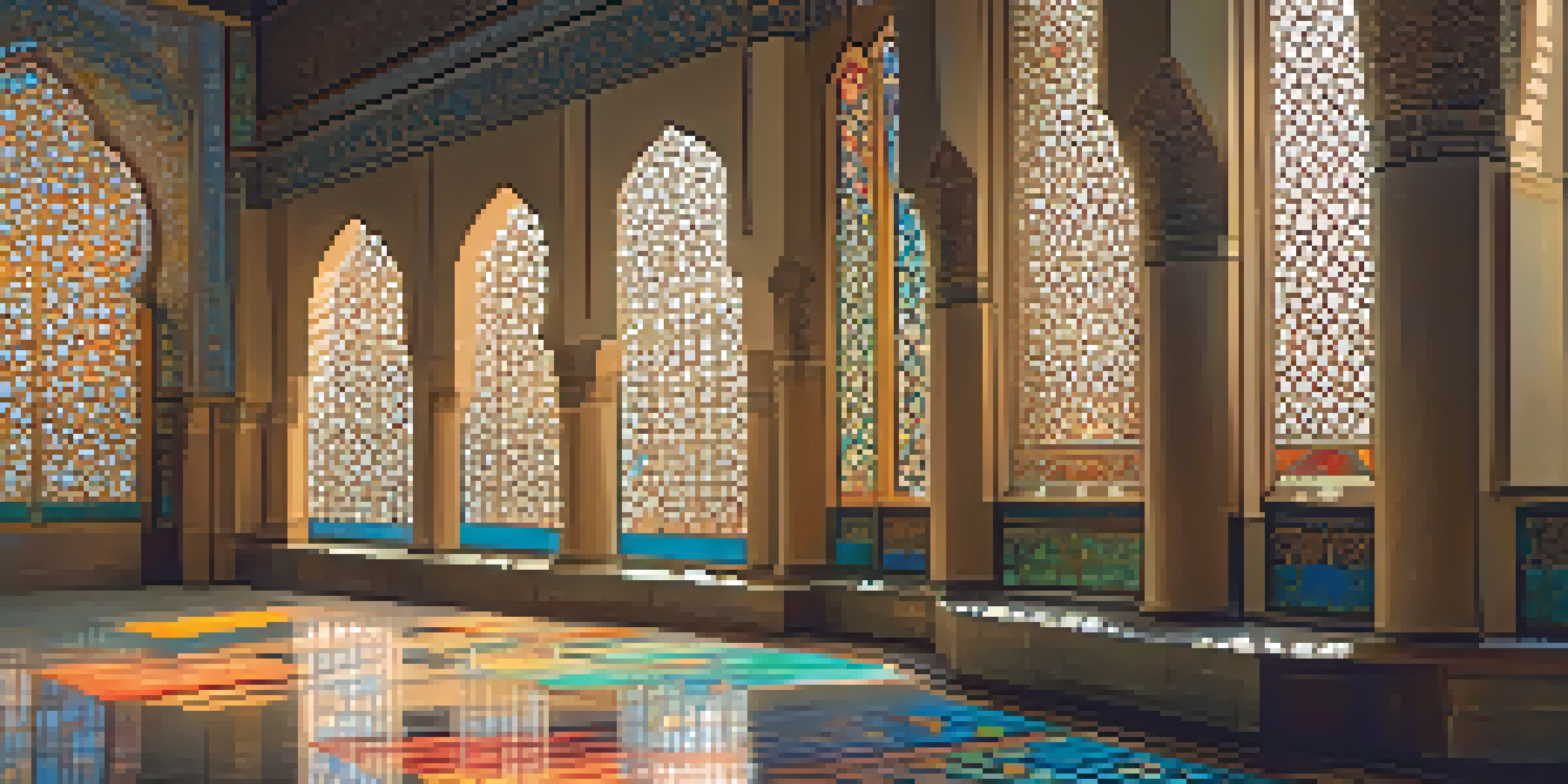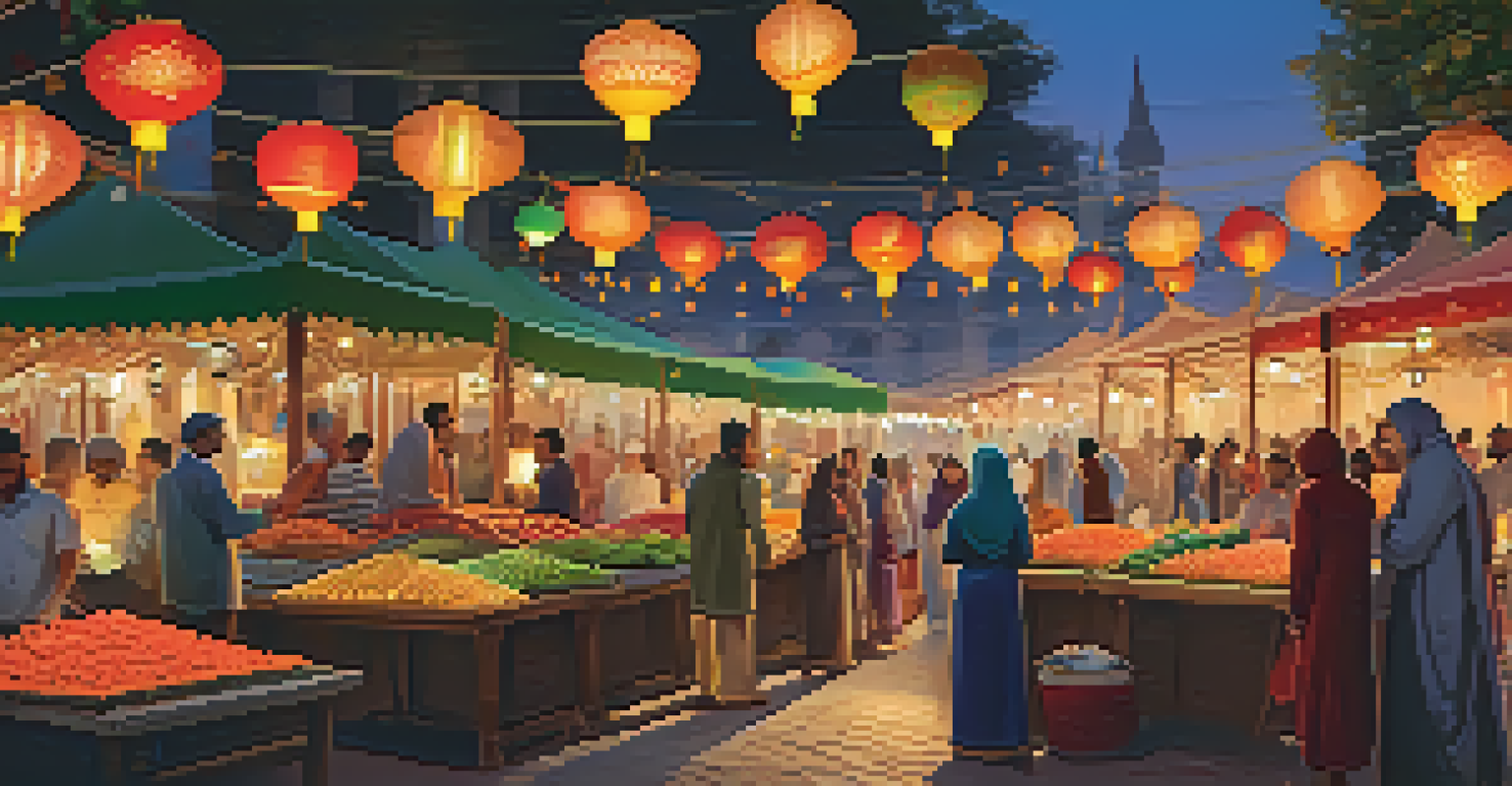The Function of Art in Islamic Religious Practices

Understanding the Essence of Islamic Art
Islamic art is a rich tapestry woven from centuries of cultural and religious influences. At its core, it reflects the values and beliefs of Islam, serving as a medium for spiritual expression. Unlike many other artistic traditions, Islamic art often avoids direct representation of living beings, focusing instead on intricate patterns and calligraphy.
Islamic art is a reflection of the spiritual and cultural values of Islam, serving as a means to express faith and devotion.
This emphasis on abstraction and geometry invites observers to reflect on the infinite nature of creation, making art a form of meditation. The use of vibrant colors and elaborate designs can evoke emotions and foster a sense of connection with the divine. Thus, Islamic art is not merely decorative; it serves a profound spiritual purpose.
In this way, understanding Islamic art involves recognizing its role as a bridge between the material and spiritual worlds. Whether in mosques, books, or everyday objects, it invites both the creator and the viewer to engage in a deeper dialogue with faith and culture.
Art as a Means of Communicating Faith
Art in Islamic practices serves as a vital means of communicating and reinforcing faith. Through calligraphy, for example, artists inscribe verses from the Quran, transforming words into beautiful visual forms. This not only beautifies spaces but also reminds devotees of the teachings of Islam as they go about their daily lives.

Moreover, the use of art in religious settings, such as mosques, creates an atmosphere conducive to worship. The intricate designs and serene aesthetics encourage contemplation and reflection, allowing worshippers to immerse themselves in their spiritual journey. The environment becomes a canvas for expressing devotion, enhancing the overall experience of prayer.
Islamic Art: A Spiritual Expression
Islamic art serves as a medium for spiritual expression, reflecting the values and beliefs of Islam through intricate patterns and calligraphy.
Art thus acts as a conduit for faith, promoting a deeper understanding and appreciation of Islamic teachings. By engaging with artistic expressions of faith, individuals find inspiration and a renewed sense of connection to their beliefs.
The Role of Calligraphy in Islamic Art
Calligraphy holds a special place in Islamic art, often regarded as the highest form of artistic expression. This is largely because writing is a direct way to convey the words of Allah, making it sacred. Artists meticulously craft each letter and curve, infusing their work with spirituality and reverence.
Art is a universal language that transcends boundaries and speaks to the heart of humanity, fostering a sense of shared identity and community.
The beauty of Arabic calligraphy lies not only in its aesthetic appeal but also in its ability to convey profound messages. Calligraphers use various styles, from the flowing thuluth to the more angular kufi, each evoking a unique emotional response. This art form allows for personal interpretation, inviting viewers to ponder the meanings behind the words.
In many ways, calligraphy transcends language barriers, speaking to the heart of anyone who encounters it. It encapsulates the essence of Islamic art, merging the spiritual with the visual, and reminding us of the power of the written word.
Geometric Patterns: Symbolism and Spirituality
Geometric patterns are a hallmark of Islamic art, serving both decorative and symbolic purposes. These intricate designs often reflect the unity and order of the universe, embodying the belief in a single, all-encompassing God. The repetition and symmetry found in geometric art evoke a sense of harmony and balance, which are central to Islamic teachings.
Moreover, the use of geometry in art can be seen as a reflection of the infinite nature of creation. Patterns can extend endlessly, symbolizing the eternal and unchanging nature of Allah. This invites viewers to contemplate their place within the cosmos and the divine order that governs existence.
Cultural Diversity Shapes Islamic Art
The rich diversity of cultures within the Muslim world influences Islamic art, resulting in unique artistic expressions that embody local traditions while adhering to Islamic principles.
Thus, geometric patterns become more than mere decoration; they are a visual representation of spiritual truths. They encourage reflection and connection to the divine, making them an essential component of Islamic religious practices.
The Influence of Cultural Diversity on Islamic Art
Islamic art is deeply influenced by the diverse cultures and traditions within the Muslim world. As Islam spread across continents, it absorbed elements from various civilizations, resulting in a rich amalgamation of styles and techniques. This cultural exchange has led to the creation of unique artistic expressions that reflect local traditions while adhering to Islamic principles.
For instance, Persian miniatures showcase intricate details and vibrant colors, while Andalusian art features a fusion of Islamic and Christian elements. This diversity enriches the overall tapestry of Islamic art, making it a dynamic and evolving form of expression. Each region adds its own flavor, creating a global conversation about faith and creativity.
This blend of cultural influences highlights the universality of Islamic teachings. Regardless of geographical boundaries, art continues to serve as a unifying force, fostering a sense of shared identity among Muslims worldwide.
Art in Islamic Rituals and Celebrations
Art plays a significant role in Islamic rituals and celebrations, enhancing the spiritual experience for participants. During events such as Ramadan and Eid, decorative elements like lanterns, banners, and intricate patterns adorn homes and mosques. These artistic expressions create a festive atmosphere that reflects the joy and significance of the occasion.
Furthermore, art is often integrated into religious ceremonies, such as weddings or communal prayers. The use of music, poetry, and visual art during these events helps to elevate the spirit of worship, allowing participants to engage more deeply with their faith. Art becomes a vital component of communal identity and shared experience.
Modern Adaptations of Islamic Art
Contemporary artists are innovating within Islamic art, blending traditional techniques with modern aesthetics to keep the art form relevant for new generations.
In this way, art not only beautifies but also enriches the fabric of Islamic life. It fosters community bonds and creates lasting memories, reminding individuals of the collective nature of their faith.
The Future of Islamic Art in a Modern World
As society evolves, so does Islamic art, adapting to contemporary contexts while remaining rooted in tradition. Many modern artists are exploring innovative techniques and mediums, blending traditional practices with modern aesthetics. This fusion not only keeps the art form alive but also makes it relevant to new generations.
The rise of digital art and social media has also transformed how Islamic art is shared and appreciated. Artists can now reach a global audience, showcasing their work and engaging in dialogues about faith and creativity. This connectivity fosters a sense of community and allows for diverse interpretations of Islamic art.

Looking forward, the future of Islamic art is bright, with endless possibilities for creative expression. By embracing change while honoring tradition, artists can continue to inspire and evoke the spiritual essence of Islam in a rapidly changing world.